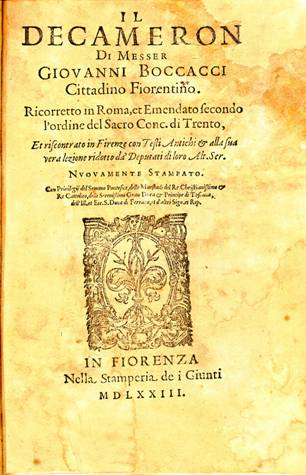Favola Boccaccesca (1980)
Symphonic Poem based on the opera Suor Isabella
Duration: 20 minutes
3(pic)3(ca)4(bcl)3(cbn)/4331/timp.3perc/cel.hp/str
Commissioned by the Dallas Symphony Orchestra
Premiere Performance: March 6, 1980; Dallas Symphony Orchestra;
Eduardo Mata, Conductor
Reviews:
…The work has a strong musical line that follows the narrative of the opera. The frequent shifts of tempo and mood build into Rodríguez’ splendidly garbed interpretation of a famous Saltarello that has survived the Middle Ages…The piece owes part of its charm to the saltarello and other Medieval tunes – the greatest hits of the thirteenth century – that Rodríguez deftly weaves with strands of more modern texture. Like many composers of all periods, Rodríguez loves such complexity for its own sake, but his intricate structural theories do not get in the way of the shape of the piece, which increases in intensity toward a clear climax…Rodríguez has a keen sense of performance and a desire for an audience and for interpreters of his work. Those traits have been rare in twentieth-century composers, especially those who have matured in the last thirty years. With such an outlook, and with so much talent, Rodríguez might well become one of the major American composers of his generation…
W.L. Taitte, Texas Monthly
...the music Rodríguez has woven was fascinating in the actuality of performance. It is obviously music for the theater – dramatic, usually playful, often slyly burlesque, rhythmically complex, rampant in its color sense… I have not heard a great deal of Rodríguez’ writing in larger forms, but Favola Boccaccesca strikes me as softer and more tonally grounded than is his norm. It certainly speaks strongly on the strength he draws from the formal practices of the past and the highly organized nature of his mind and his musical outlook…music of purpose and clarity which communicated persuasively.
John Ardoin, Musical America
 Program Note:
Program Note:
Favola Boccaccesca (fable of Boccaccio) is a symphonic poem based on a story from Boccaccio’s Decameron (1353 and was written as a study for Rodríguez’ one-act opera, Suor Isabella ossia Il Saltarello de’ Veli (“Sister Isabella or The Dance of the Veils”). Suor Isabella is a comedy: distinctly ribald, in keeping with many of the stories in Boccaccio’s collection. The story is set in a convent (not unlike a parody of Puccini’s Suor Angelica), and deals with a beautiful young nun who smuggles a lover into her cell and is punished by her Mother Superior but forgiven when it is discovered that the Mother Superior has a priest in her room. In the score, the musical ideas and proportions are drawn from the opera’s scenario. Included are depictions of the nuns’ suspicions of Isabella, the priest’s entrance (in a trunk, which is dropped), Isabella’s sweet music, and the opera’s finale (in which it is discovered that the Mother Superior is wearing not her veil but the trousers of the priest and all join in a rollicking round dance).
Scored for large orchestra (strings, harp, celesta, winds by threes and fours, and nearly thirty percussion instruments), Favola Boccaccesca is, in effect, a concerto for orchestra. There are some instrumental depictions of characters: a solo violin for Sister Isabella and lower brass for the Mother Superior. Given more prominence, however, are the solo woodwinds, who dominate the score with scherzando figuration and provide a sharp contrast to the more lyrical strings and harp. Trumpets and drums, not often featured in Rodríguez’ works, serve admirably here to suggest the violent extremes the composer sees as characteristic of Medieval life: one moment festively outlining early dance forms, then suddenly warning of Final Judgment and the flames of Hell.
Favola Boccaccesca draws heavily upon its Medieval roots in matters of structure as well as in the use of actual Medieval melodies woven into the musical texture. Inspired by early mensuration canons, the rhythmic patterns range from simple 2:1 ratios to several complex contrapuntal layerings of cross rhythms (5:7, 7:8, 4:10, etc.) in a variety of meters. One such building block is made to recur in accordance with Ars Nova isorhythmic techniques. Constructed in a series of episodes which are unified by variations of these materials, the work is in one large-scale movement. Ten main (constantly shifting) tempos, some of them created by metric modulation, provide both unity and variety as the tempos alternate and recur – much as the story tellers alternate during the ten days of the Decameron.
Of the actual quotations employed, the most important is a famous Saltarello (or “jumping dance”) of the Boccaccio’s time. It is this tune which generates the irreverent sub-title, Il Saltarello de’ Veli: a musical pun on the Italian saltero (or “psaltery”), a term used to describe the harp-shaped head-covering (“psaltery of veils”) worn by nuns of the period; and it is of the many layers of variants and countermelodies added to the tune in a 12-tone/Neo-Medieval version of descant technique that the main musical material of the work consists. This secular tune contrasts with several more decorously ecclesiastical melodies which are developed in a similar fashion. These include a Cunctipotens genitor, the Spanish Quen la Virgen, a highly disguised fragment of the Dies Irae and, appropriately for the Mother Superior, a hymn of St. Ambrose originally composed to combat heresy. Bell patterns heard by the composer in the village churches near Bellagio, Italy are quoted at the opening of the work and at its close.